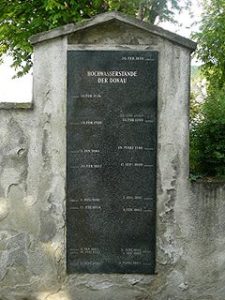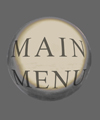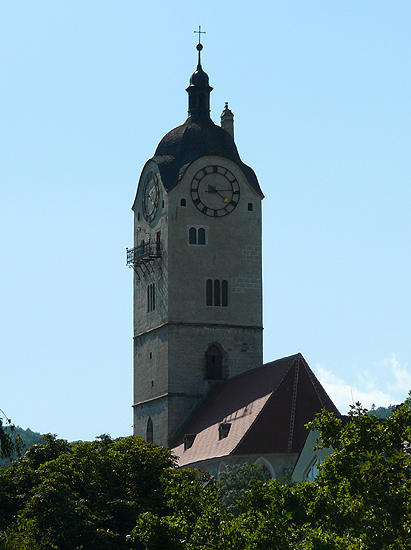Stein occupies a narrow strip of land between the steep slopes of the valley and the River Danube. Approaching from the East, one enters the town through the Kremser Tor and finds oneself in the Steiner Landstraße which runs the length of the town. As the steeply pointing roof of tower suggests, the gateway is a Renaissance structure. Built in 1470, it was given a more Baroque look in around 1700.
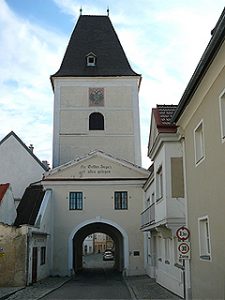
The gateway is the starting point for a tour given in German by Christine Emberger in which Stein is revealed to visitors through the eyes of a night watchman from the Middle Ages. For details on these and other of tours see: www.christine-emberger.at.
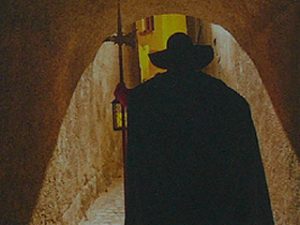
Although the fabric of all the houses on the Steiner Landstrasse dates from the Middle Ages, buildings were repeatedly adapted and rebuilt over the centuries so that today, the appearance of the town is largely defined by the seventeenth and eighteenth centuries. Nevertheless, earlier architectural fragments may be found and immediately after entering Stein through the Kremser Tor, on the right-hand side there is a fragment of Late Gothic decoration. During the Renaissance, in Central Europe apart from Renaissance styles of architecture buildings were often built in a more Medieval-looking style known as the Late Gothic. This included the use of interconnecting rods as adornments on doorways, window-frames and supports such as on the extending bay on the right-hand side of the Steiner Landstrasse immediately after the Kremser Tor. Once common, Late Gothic pipework is now rare.
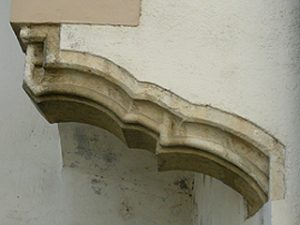
Dating from the fourteenth century and thus from the Medieval Ages proper, taking the first right and following the Göttweigerhofgasse North leads to the three-sided Gottweigerhof or courtyard. This was where the factor of Göttweig Monastery lived and the courtyard was an agricultural collecting yard where crops and tithes were gathered together for processing, sale and storing.
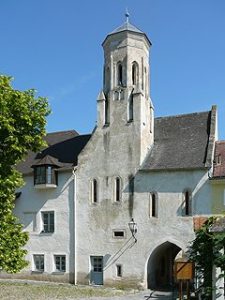
Built over the southern entrance, there is a Gothic chapel with an eight-sided tower, the key of which can be borrowed from Museum Krems. This costs € 2,- per person and includes a highly informative folder which is available in either English or German. The frescos that decorate the chapel, hallway and oratorium are important examples of Gothic mural painting and the interior features rib-vaulting and niches. Crossing the courtyard and going through the third archway, leads out of the old town and looking at the eastern wall, it can be seen that the north and eastern sides of the courtyard formed the north-eastern corner of the city wall and accordingly have a strongly defensive character.
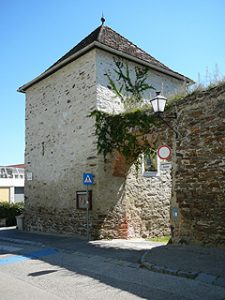
On the southern side of the Steiner Landstrasse, the south-eastern corner of the citywall is largely obscured but can be glimpsed if one stands at Steiner Landstraße 10 and looks through the entrance to the courtyard opposite towards the South-West.
Parallel to the Steiner Landstrasse, on the southern side there there is the Donaulände, which like the Landstrasse runs the length of the town and separates it from the river. As goods were hauled up-river in long conveys that involved three barges, eighty men and as many horses, there were no harbours as such. Rather, in a laborious process, the convey would slowly approach the banks, with barges and auxiliary craft being secured by one means or another once a standstill had been achieved. To this effect, many houses on the Donaulände have iron rings built into their walls which were used for the mooring of barges and other craft. As they were part of the city-wall that protected the town, the walls of these houses are very thick.
Directly South of the Kremser Tor is a landing stage where river cruises along the Wachau Valley can be booked and the ferry boarded. An open air exhibition gives an introduction to the history and culture of the Wachau which along with the old town of Krems and the abbeys of Göttweig and Melk was accepted as a world heritage site by the UNESCO in 2000. This is also the starting point for another tour given by Christine Emberger that introduces the once lively and now lost world of the „shippers“. Often the barges carried wine upstream and iron and salt downstream as well as wood, stone and luxury items. For more on the historic shipping on the Danube see the article A Hard Pull up – a fast Drift Down.
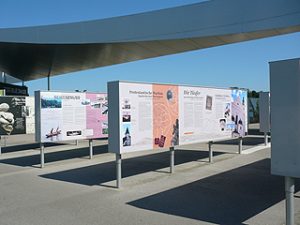 At Steiner Landstraße 24, there is „Zorba’s Taverna“ which can be recommended to those who like Greek cooking and wine. See www.taverne-zorbas.com. This house derives its appearance derives from its being rebuildt in 1562.
At Steiner Landstraße 24, there is „Zorba’s Taverna“ which can be recommended to those who like Greek cooking and wine. See www.taverne-zorbas.com. This house derives its appearance derives from its being rebuildt in 1562.
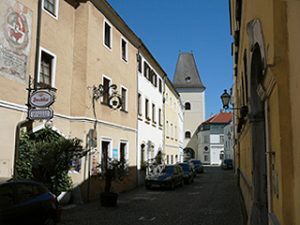
At Steiner Landstrasse 27 and 27a and forming a side of the Minoriten Platz, there are two imposing houses in which salt was stored prior to re-sale. These were built in 1579 and testify to the importance of the salt for Stein. The salt was shipped in small craft down the River Traun and then transferred to larger vessels for shipping along the Danube. For hundreds of years only Stein had the right to buy and sell in salt but with the Renaissance, Krems was also allowed to partake in this lucerative trade. Inside, the buildings feature closely placed, extremely thick beams which designed to support the heavy product that was stored on the first floor. Storing on the first floor guarded against the floods caused by the melting snow in the spring and which occurred every five years. At number 72, there is the „Salzstadl“ a traditional Gasthaus that also runs a stage for cabaret, concerts and lectures. See www.salzstadl.at.
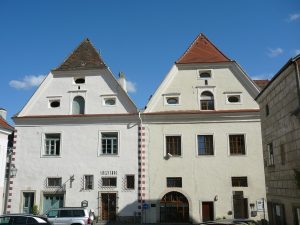
Continuing on West, either along the Steiner Landstraße or along the Danube tow path, one arrives at Ludwig-von-Köchel-Platz, named after the prominent Mozart scholar, Ludwig Ritter von Köchel, who was born in Stein in 1800. The so-called „Köchel-Verzeichnis“ (KV) was first published in 1862 and still to this day is a standard work of reference that is used by Mozart scholars throughout the world. Apart from writing extensively on music, Köchel also conducted botanical and mineralogical studies and was seen by his contemporaries as exemplifying the ideal of the universal man. In his will, he left a large part of his mineralogical collection to the Piarist School in Krems, where he himself was once a pupil and where the specimens he donated are still used as teaching aids to this day.
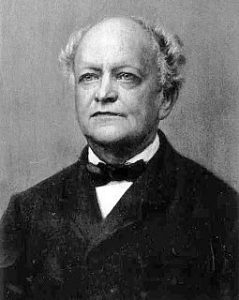
Ludwig Ritter Alois Friedrich von Köchel (1800-1877)
On the North side of the square, the building with painted brickwork is the Grashof which was originally a defensive structure and up until the eighteenth century, was where the town hall was.
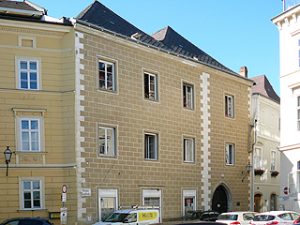
On the western side of the square traditional ladies‘ costumes with an innovative twist may be found, along with textiles, hand-blown glass, enamel ware and traditionally made wicker baskets. Around the corner at Donaulände 56, there is „The House of Regions“ where concerts, cabaret shows and lectures are held and where there is a bookshop where books and CD’s with a regional focus are also available. Among the events held at the House of Regions are the „Kremser Fireside Talks“ where every autumn, pairs or trios of experts from different fields are invited to discuss current themes pertaining to society, the future and our conceptions of how we wish to live. The House of Regions was previously known as the Gasthaus zum Elefanten as it was here that in 1551, an elephant named Solomon and his mahout, Subhro, spent a night. The elephant was a wedding present from the king of Portugal, King João III, to Archduke Maximilian of Austria and Solomon and Subhro walked all the way from Portugal to Vienna. Everywhere they went they were seen as a great marvel and in the towns and villages where they stopped, inns and hostels recorded the event by renaming themselves with such names as „Elephant’s Rest“ and the „Elephant’s Guest House“. The portico was originally a landing-stage where Motzart and his father disembarked on the composer’s first journey to Vienna.
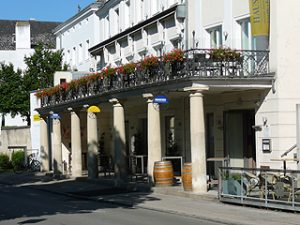 Following the Steiner Landstraße brings one to the Church of Saint Nicholas, which is Stein’s parish church. Once visible from the river, on the South side of the building there is an over life size image of Saint Christopher that dates from 1537. As he successfully carried Jesus across a river despite the ever growing weight of the cares of mankind that Jesus bore, Saint Christopher was popular among the shippers and the fresco shows the Saint stepping into the river with the Christ Child on his shoulder.
Following the Steiner Landstraße brings one to the Church of Saint Nicholas, which is Stein’s parish church. Once visible from the river, on the South side of the building there is an over life size image of Saint Christopher that dates from 1537. As he successfully carried Jesus across a river despite the ever growing weight of the cares of mankind that Jesus bore, Saint Christopher was popular among the shippers and the fresco shows the Saint stepping into the river with the Christ Child on his shoulder.
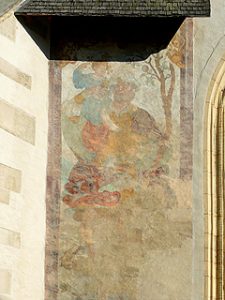
The church is first mentioned in the fourteenth century, with the current structure dating from the fifteenth century. Built in a Late Gothic style, inside there is a kind of webbed rib vaulting that is typical for the region. During the eighteenth century, the church was fitted out with a dominating array of Baroque furniture which at the beginning of the twentieth century, was replaced by a much lighter Neo-Gothic selection. Nevertheless as a tribute to the acclaimed painter, Martin Johann Schmidt, who lived and worked in Stein and who is buried in the town cemetery, a large altarpiece painted by the artist was allowed to remain. This is located in an alcove on the North wall and shows Saint Nepomuk. A side altar on the South side of the church also features a painting by Martin Johann Schmidt and shows the church’s patron, Saint Nicholas. Reflecting the importance of the river, both altarpieces address saints who may be called upon by those in danger of drowning and the saints are depicted in the process of saving people from watery graves. Nine other paintings in the church by Martin Johann Schmidt were sold in order to pay for the new Neo-Gothic fittings. Nevertheless the pews, the font and the church organ are all Baroque. The Neo-Gothic fittings are well designed and masterfully executed and admirable compliment the Late Gothic architecture. While the small main altar allows light from the specially commissioned stained glass windows to flow in, the pulpit is particularly gracile, despite the fact that it is surmounted by an almost life statue of Saint John the Baptist. All this serves to re-endow the church with an airy quality that for two hundred years was suppressed.
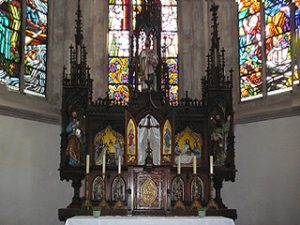
Behind the church, steps lead up to the Church of our Lady, with buildings built into the rocky overhang. Both the Church of Our Lady and the Rebentor that is situated a little higher up, offer panoramic views over the town. It is here the beginnings of Stein as a settled community are to be found and the Church of Our Lady stands on the site of a church that dates from the eleventh century, the foundations of which in turn, stand on a structure that dates from the Roman era. The first people to live on the rocky outcrop were probably a people known as Slavs who are known to have inhabited the Northern banks of the Danube during the Late Roman Era and the Age of Migration. A short distance southwest of the church there is the well from which, for hundreds and perhaps thousands of years water was drawn. Once a busy meeting point, it is now a tranquil spot where a refreshing drink of spring water may be enjoyed.
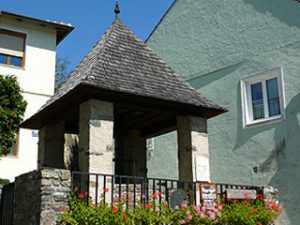
In 1263, the still unfinished Church of Saint Nicholas was made the official parish church and the upper church was dedicated to the Virgin Mary and became known as the Frauenberg Kirche or „Ladyhill Church“. The church’s current form derives from the 1380’ies with the interior dating from around 1470. Meanwhile the tower dates from late sixteenth century and is capped by a distinctive Baroque roof. The tower has seven stories and unusually there is a chimney. This is because up until 1970, the top floor was where a watchman lived who would keep a lookout for outbreaks of fire. In 1966, the church was dedicated to the memories of those who had fallen during the First and Second World Wars.
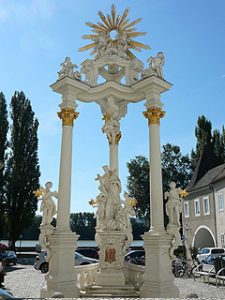
Continuing on along the Steiner Landstraße, one comes to Rathausplatz with a three columned monument honouring Johannes Nepomuk (1350-1393). Nepomuk was a Bohemian priest and martyr who became popular during the eighteenth century. Nepomuk was martyred by being thrown into the River Moldau from the Charles Bridge in Prague and left to drown. An inversion of the circumstances of his death made Nepomuk a patron saint of bridges who offered protection against death by drowning. Among those who invoked him were the shippers and according to legend, as his body floated downstream, it was accompanied by flickering tongues of fire. Like the Virgin Mary, he is therefore often depicted with a halo adorned with five stars and it is for this reason that on the monument, the five cherubs surrounding him, all hold stars. It should be noted that the 1855 date given on the pedestal below the Saint, is a date of restoration. Built in 1715, the monument utilises the latest in Baroque illusionist technology and suspended from the baldachin, a cloud and a cherub are held aloft by a chain.
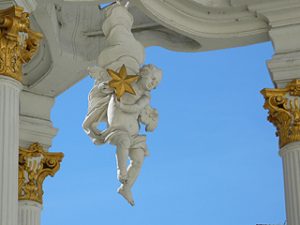
After the Rathausplatz, in the Kleine Passauerhof, at number 74, there is the dressmaker and fashion designer Martina Wagensonner www.wagensonnerfashion.raumusik.at. Next door, at Steiner Landstraße 76, there is the Großer Passauerhof, which has a Renaissance façade topped by dog-tooth castillations and ornamental, miniature turrets. Krems and Stein belonged to the Bishopric of Passau and the „Large Passau Courtyard“ was the bishop’s episcopal residence in Krems-Stein. The building was originally three houses that in the middle of the sixteenth century, were moulded into one. Like the Göttweigerhof, the courtyard was an agricultural collecting yard where the factor lived and where crops were collected and grapes were pressed to make wine that was stored in the cellars below. Here Ludwig von Köchel’s father, who was in charge of running Passauerhof estates, could look down and see whatever was being delivered in the courtyard and it was in this house that Köchel was born. The Großer Passauerhof is where an internet faculity, The Köchel Prominade, hosted by the Köchel Society, begins a musical tour of Krems, Stein, and Gneixendorf. With a smart phone this can be used as an audio guide, that with a commentary and musical examples, introduces the musical soundscape of Krems and the Wachau. Unfortunately only available in German, this informative application features twenty stations which can be called up by entering: www.musikinkrems.at. Also at Steiner Landstrasse 76 is Il Magazzino, where a range of Italian specialities may be purchased. These include fine wines, grappa, cheese, charcuterie, tinned products, pasta and all manner of preserves and biscuits. Artisan bread and rolls are delivered by the baker Brotocnik, from Waldviertel, the wooded plateaux that lies to the North of Krems and Stein. For those in need of refreshment, wine, coffee aperitifs and antipasti are served. For those who cook, there are books on Italian cooking. See www.il-magazzino.com for opening times.
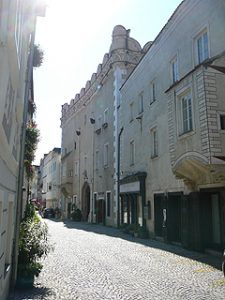
Continuing on along the Steiner Landstraße, one comes to Schürerplatz, which is very much the living heart of Stein. From the first shop on the right-hand side, ice-cream may be bought and enjoyed next to the fountain at the centre of the square. Wine, cakes, ravioli and other Italian specialities are also available. On the same side but opposite corner of the square, there is Café Hartl where the locals meet. Also at Schürerplatz there is a newsagent with postal services, a chemist’s and the award-winning pizzeria, Firenze. See www.firenze-krems.at. In the direction of the Danube, after Firenze, there is a statue of Martin Johann Schmidt. Next to the newsagent, the so-called „Manzetti House“ is named after an eighteenth century Mayor of Stein. As it was in this house that Ludwig von Köchel’s parents spent their last years, it was assumed that this was where the prominent son was also born and a plague incorrectly announces the house as Köchel’s birth place.
Next to Café Hartl and opposite the Manzetti House, there is the „Toll Collector’s House“, which, dates from 1536 and is a masterpiece of Northern Renaissance architecture.
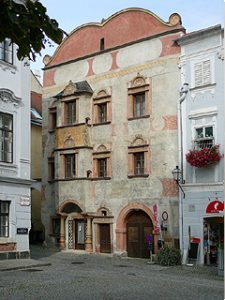
The Toll Collector was the person who organised the tolls that were due for crossing the bridge situated just outside the town at the western end. The bridge was built at the end of the fifteenth century and remained standing until the end of the nineteenth century when it was replaced by the current structure. Of this, only the northern half is original as at the end of the Second World War, retreating German forces blew up the eastern half so as to delay the rapidly approaching Red Army. Due to its strategic importance, the damaged bridge was rebuilt by the Russians, with plaques in Russian and German announcing this at the southern end. At ground floor level, the most noticeable feature of the Toll Collector’s House are the columns that support the bay-window. These derive from a tradition that, lacking an in-depth acquaintance with the Greek orders of architecture, did not distinguish between genuine Roman capitals and their Romanesque descendants. This misunderstanding lead however to an innovative and unrestrained approach that resulted in a uniquely South German style of Renaissance architecture and design. To find out more about the house and its archtectural style see the article The World’s a Labyrinth! Krems and Stein during the Renaissance.
At Steiner Landstrasse 90, there is the Holzinger House which was built by Christoph Holzinger between 1595 and 1599. Over the entranceway, a relief shows a knight in armour holding an up-raised chalice while below him, the key-stone shows Holzinger’s coat of arms accompagnied by a lion and a griffin on either side.The letters CHVL stand for „Christoph Holzinger von Linz“.
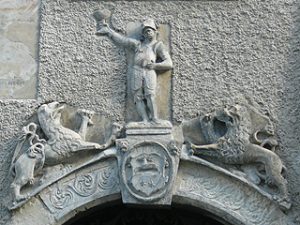
Holzinger’s coat of arms were bestowed on him by Emperor Rudolf II for his services in the wars against the Turks and after retiring from the army, he administrated the Salt Office in Krems and Stein. This appears to coincide with his settling in Stein and rebuilding the house, with the interiors decorated with moulded Renaissance relief elements. Soon becoming a burghess and a member of the town council, in 1605 he was elevated to the nobility and awarded a second coat of arms which is shown on the keystone of the house next door at number 88. This he bought 1608. In addition to other properties he also bought the Janaburg in Mautern and from 1624 he was allowed to call himself Christoph Holzinger of Janaburg.
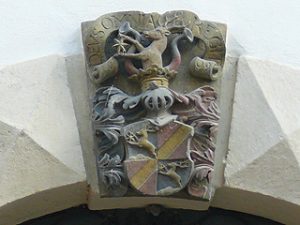
The fragmented frescos on the facade of number 90 are dated to between 1540 and 1580 and show Saint Florian, the patron saint of fire-fighters and Lucretia, both accompagnied by verses that can no longer be reconstructed. Saint Florian chose to die as a martyr rather than renounce Christianity and Lucretia, after she had been raped, chose to die rather than live as one defiled. Whether there is a connection and a message here is unsure but from the relief of the knight one can see that although he holds his chalice up in welcome, the self-confident vivaciousness of the Renaissance is beginning to fade and a limpness has begun to set in that is matched in religion by the dogmaticism and intolerance of the Counter-Reformation and the embracing of high-minded ethics in which love and forgiveness are secondary to principle. In view of Holzinger’s rapid career, it is unlikely that he was a Protestant.
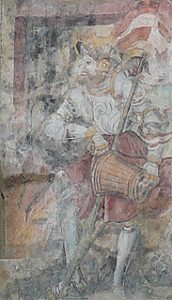
Dating from the same period as the Toll Collector’s House but built in the Late Gothic style, at Steiner Landstraße 92 there is the Karlingerhof, also known as the „Green Castle“. Although this appears Medieval it is in fact Late Gothic and if one looks at the remaining decoration, one can see that the motif’s and imagery are far removed from the Gothic and exemplify a style of decoration known as „grotesque“ that was en vogue during the Renaissance. For more on grotesque painting and how the fragments of decoration on the Green Castle are related to that of the Toll Collector’s House, see the article, The World’s a Labyrinth! Krems and Stein during the Renaissance.
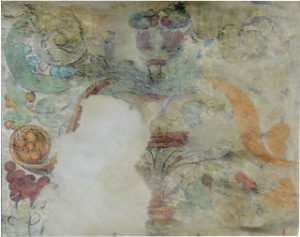
Continuing on along the Steiner Landstrasse one comes to Johann-Michael-Ehmann Platz. If one crosses the square and turns down towards the river, on the western side of the street at the base of what was once a gateway, a relief known as „The Bathing Jesus“ may be seen. This derives from the fact that floods often subjected the Saviour to a partial and sometimes total immersion.

As the florally-derived decoration is related to that on the Green Castle, the transposed fragment can be assumed to date from the Renaissance. On the other side of the street, a mooring ring for barges may be seen. Returning to Johann-Michael-Ehmann Platz, there is a statue of the Virgin Mary flanked by Saint Sebastian and Saint Rochus. This was errected in 1744, with the 1817 date being, as at Rathausplatz, a date of restoration.
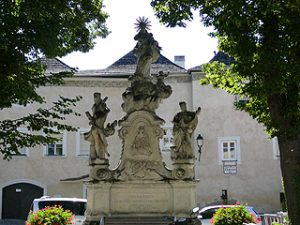
Johann Michael Ehmann was the architect who in 1786 was awarded the commission of re-building the church and monastery at Maria Langegg. Located on the other side of the river in the Dünkelsteiner Wald, during the seventeenth century, Maria Langegg became a place of pilgrimage to which the citizens of Stein repeatedly journied to in times of plague. For more on the Rococo church and monastery at Maria Langegg and the playfully innovative frescos by Johann Adam Ritter von Mölk see the article Where God whiles …
For those interested in a diversion or a longer walk, turning right into the Reisperbachstrasse leads to an old mill and house numbers 50-57. Prior to redevelopment, this was where Stein’s communal brick-works were situated and while clay was being dug from the hill in order to make the bricks, was where the first signs of a human presence were found in the area. See the article „An Ice Age Corridor“ for more. Following both of the roads on up the valley leads to the Hubertus Hut where one can then either turn sharp right and right again in order to arrive at Egelsee where, turning left, one can walk on up to the Danube Outlook Tower before walking down through the vineyards back to Stein and Saint Nicholas‘ church. Alternatively, sticking to the left one can follow the Reisperbach stream up to the hamlet of Scheibenhof. Here in 1570, the first copies of a Protestant agenda of service were printed. This was an important document for Protestants living in the Habsburg Empire and the printing of the book can be seen as the climax of the Protestant movement in Austria. During this period much of the Wachau and many of the people living in Krems and Stein were Protestant. Coupled with this is the fact that the second half of the sixteenth century was also the period during which the two towns were at their most influencial and prosperous. In retrospect one can therefore see the circumstances under which The Agenda was printed as a portent of the turmoil that the later decades were to bring.
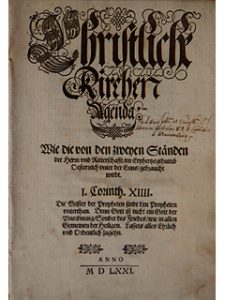
Written in 1569 by David Chyträus in Spitz (some 15 Kilometres up river from Krems and Stein), The Agenda was only granted imperial approval after it had been worked over by Christoph Reuter who some years before had bought Scheibenhof and converted it into a Renaissance villa. To avoid upsetting the Catholic fraternity at Court, the Emperor’s sanction was never officially announced and permission to print was given on the condition that the work be carried out in a secret, out of the way place. As Scheibenhof appeared to fit the bill, this was where the first copies of The Agenda were printed.

Not as secluded as had been hoped, word leaked out that something subversive was going on and whilst Emperor Maximillian II (1527-1576) was away, the printer and his assistants were arrested and imprisoned. Though the matter was later clarified, the operation was transferred to the more remote location of Rosenburg and printing resumed in 1571. Although both Maximillian and his successor, Rudolf II (1552-1612) had Protestant sympathies, this was not shared by Rudolf’s brothers who worked hard at inaugurating and promoting the Counter-Reformation in Bohemia, Hungry and Lower Austria. In 1589, the citizens of Krems and Stein were urged to return to the Catholic faith but in an act of open defiance refused. For this, the various trading privileges that the two towns had enjoyed for over a hundred years were taken away. As a consequence, many protestants left and prosperity plummeted.
Returning to the Steiner Landstrasse, at number 102 there is the schnapps distiller Bailoni. Since 1872, Wachau apricots have been mashed, fermented and distilled here to make an award winning schnapps that is sold in distinctive bottles. The Bailoni story begins when Eugenio Bailoni met Rosa Amon whilst travelling in Austria. Romance blossomed and the distiller’s son soon enough found himself moving to the Wachau where he quickly realised that the region’s apricots could be distilled. In due course the 1st Wachau Apricot Distillery was established and quickly became a flourishing business. The schnapps is well-rounded and only moderately sharp. Made in the courtyard behind the shop and in an extensive system of underlying cellars, tours are available for groups by prior arrangement. See www.bailoni.at.
At number 106 and 108 there are two houses with Late Gothic window frames decorated in the same style as the fragment next to the Kremser Tor. This dates from 1500 and as can be seen from the ends of the stone beams that support the protrusion of the first floor, the house was once a bakery and the emblems are the baker’s bakery products.
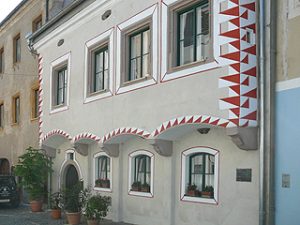
Steiner Landstraße 122 is the house where Martin Johann Schmidt lived and worked. The house features a private chapel and in order to have the space to execute the larger pieces that he was often commissioned to paint, above his studio on the first floor, he had the floor of the second story removed.
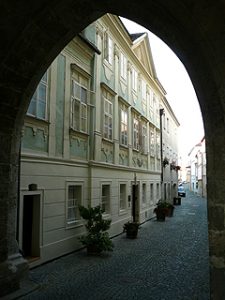
For those who can follow German, a well researched and highly informative tour given by Christine Emberger reconstructs the life and times of this versatile and vivacious artist. The starting point of the tour is the westward gate, which facing in the direction of Linz, is called the Linzer Tor and is characterised by a Baroque mansard roof.
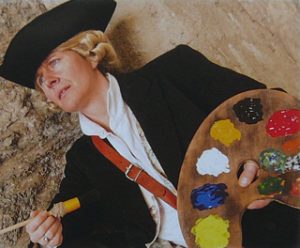
Although parts of the remains of the city-wall that once enclosed Stein date from the thirteenth century, the wall was extended in around 1480, with the Linzer Tor dating from 1455 as shown by an inscription in Gothic numbers which was preserved during the Baroque re-building. Passing through the gateway, on the North side there is the Danube Private University. The building was once a school but is now where all aspects of dental medicine are taught. On the South side there is a park named after the local composor Ernst Schandl who lived on the Donaulände and who composed a number of well-known songs that celebrate the Wachau. For audio samples of his most well-known songs, a list of works and a detailed biography see: www.ernstschandl.at. From the park, a flight of steps leads down towards the Donau Lände and at the bottom, a granite plaque shows the levels of the major floods from 1740 up until 2002.
